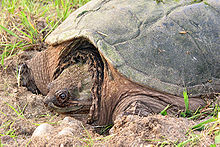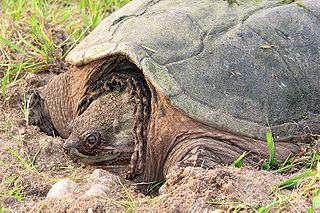
The Chelydridae is a family of turtles that has seven extinct and two extant genera. The extant genera are the snapping turtles, Chelydra and Macrochelys. Both are endemic to the Western Hemisphere. The extinct genera are Acherontemys, Chelydrops, Chelydropsis, Emarginachelys, Macrocephalochelys, Planiplastron, and Protochelydra.

Macrochelys is a genus of very large freshwater turtles in the family Chelydridae, native to the Southeastern and Midwestern United States. Only a single extant species was recognized until 2014, when a study divided it into two, or possibly three species. These turtles are easily recognized by three distinct dorsal ridges with raised spikes.

The Mexican box turtle is a species of box turtle belonging to the family Emydidae. It is sometimes treated as a subspecies of Terrapene carolina.

The New Guinea snake-necked turtle is a species of turtle in the family Chelidae. The species is found almost exclusively within Western Province, Papua New Guinea.

The Bellinger River turtle is a species of turtle in the family Chelidae. The species is of moderate size, with a straight-line carapace length to 240 mm (9.4 in) in females, and 185 mm (7.3 in) in males. It is endemic to Australia with a highly restricted distribution to the small coastal drainage of the Bellinger River in New South Wales. In the past the species was considered locally abundant. The species' preferred habitat is the deeper pools of the clear-water upstream reaches of the river, where water flows continuously in most months over a bedrock basement and a stream bed of boulders, pebbles, and gravel. A captive breeding program has been under way since a 2015 virus outbreak came close to wiping out the entire species. Most remaining individuals are currently housed in quarantine, though a small number have been reintroduced to the original habitat.

The Western New Guinea stream turtle or New Guinea snapping turtle is a species of freshwater turtle in the Chelidae family. It is found in the Bird's Head Peninsula and the Bomberai Peninsula west of Cenderawasih Bay, and on the island of Waigeo of West Papua, Indonesia.
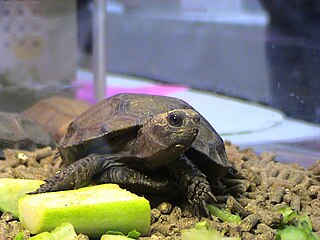
Manouria is a genus of tortoises in the family Testudinidae. The genus was erected by John Edward Gray in 1854.
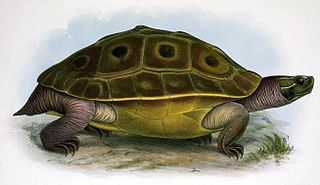
The Burmese eyed turtle, also known as the Bengal eyed terrapin, Burmese peacock turtle or swamp turtle, is a species of turtle in the family Geoemydidae of southern Asia.

The peninsula cooter is a species of freshwater turtle in the genus Pseudemys. It is sometimes considered a subspecies of the coastal plain cooter when that turtle is not itself considered a subspecies of the river cooter.

The Central American snapping turtle, also known commonly as the Mexican snapping turtle and the Yucatan snapping turtle, is a species of turtle in the family Chelydridae. The species is endemic to Central America and Mexico.
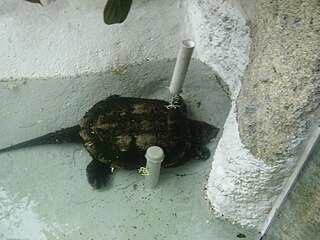
The South American snapping turtle is a species of turtle in the family Chelydridae. This species, which is endemic to Central and northwestern South America, was previously considered a subspecies of Chelydra serpentina. Its restricted range in South America reflects its recent arrival there as part of the Great American Interchange.

The Chaco tortoise, also known commonly as the Argentine tortoise, the Patagonian tortoise, or the southern wood tortoise, is a species of tortoise in the family Testudinidae. The species is endemic to South America.

Williams' mud turtle is a species of turtle in the family Pelomedusidae. The species is endemic to Africa.

Elseya schultzei, commonly known as Schultze's snapping turtle, is a species of chelid turtle endemic to northern New Guinea.
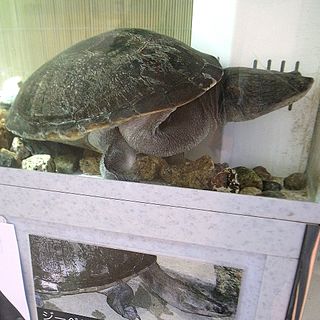
Chelodina (Chelydera) kuchlingi, commonly known as Kuchling's long-necked turtle or Kuchling's turtle, is a species of freshwater turtle in the family Chelidae. The species is endemic to Australia.
Chelodina (Chelydera) walloyarrina, the Kimberley long neck turtle or Kimberley snake-necked turtle, is a large species of long neck turtle endemic to the Kimberley region of Western Australia. In recent years, it has been unclear as to whether this was a valid species or not. It has been recognised as such by the 2017 and 2021 editions of the Turtle Checklist. In a recent paper it waslisted as a subspecies of Chelodina burrungandjii by Kehlmaier et al. 2019, however, that publication did not actually assess the type of the species nore did it analyse it. Hence it should be considered a full species.
Centrochelys atlantica is an extinct species of tortoise that lived in the Pleistocene. It was first recorded in the volcanic crater on Sal, Cape Verde. It was initially identified as similar to the extant Testudo calcarata. The species is no longer present anywhere in the Cape Verde islands. It has since been described as a new species, differentiated from C. sulcata by its smaller size and lesser robusticity. It does not seem there is any evidence this species came into contact with humans. Kehlmaier et al. (2021) identified the type material of this species as belonging to a specimen of the red-footed tortoise, making C. atlantica a junior synonym of the latter species and leaving the extinct tortoise known from fossils excavated on the Sal Island in the 1930s without a scientific name.

Centrochelys is a genus of tortoise. It contains one extant species and several extinct species:

Scott A. Thomson is an Australian herpetologist, paleontologist, and taxonomist, specialising in turtles of the family Chelidae.
Phrynops paranaensis is an extinct species of turtle from the Huayquerian Ituzaingó Formation of the Paraná Basin, Argentina, likely to be late Miocene in origin.
